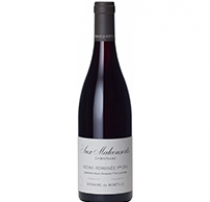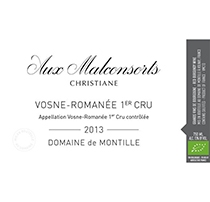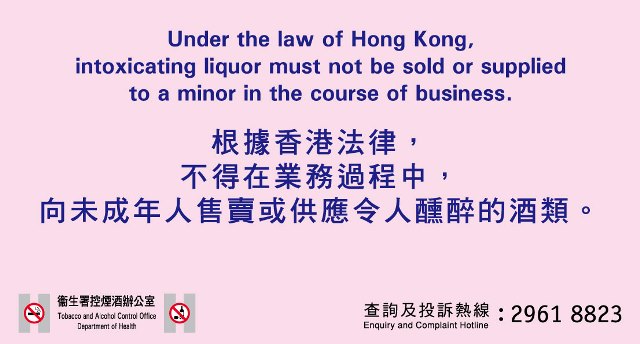| Region | Burgundy |
| Appellation | Cote de Nuits |
| Category | Red Wine |
| Classification | Premier Cru (Burgundy 1935) |

|

|
| Cat | Region | Year | Producer, Wine | Size | C(s) | Bt(s) | HKD/Cs | HKD/Bt | Score | Critic | |
| Burgundy | 2013 | Domaine Hubert de Montille, Vosne-Romanee 1er Cru Aux Malconsorts Christiane | BT12 | - | - | HK$54,720 | - | 94-96 | NM | ||
| All wines are subject to remaining unsold. We offer free delivery for purchase exceeding a certain amount. Please check Delivery Rates for details. | |||||||||||
As is often the case this is aromatically quite similar to the regular cuvée except that it is ever-so-slightly spicier and perhaps with a bit more floral influence. There is fine volume, power and punch to the big-bodied and robust flavors that retain a refined mouth feel as the tannins are once again dense but fine plus they are well-buffered by the copious dry extract that imparts a velvety texture to the strikingly long finale. One aspect where this does depart from the normal pattern is that this is noticeably more structured and will thus require a few more years of cellar time. In sum, this is impressive juice with terrific development potential.
Score: 92-95 Allen Meadow (AM), Bourghound (BH), April 2015
The 2013 Vosne-Romanée 1er Cru les Malconsorts "Christianne," which I asked to taste directly alongside the regular Malconsorts, has more delineation and precision, more mineralité coming through on the nose, veins of wet limestone and sea spray emerging with time. The palate is also noticeably different with greater tension and focus, a sense if coiled-up energy that is uncommon in this vintage. This surely illustrates the profound effects of terroir: a serious 2013 that should age with style.
It was a poignant return to Domaine de Montille as the ripples of Hubert’s passing spread across Burgundy. Reaching the end of his mortal coil with a glass of Pommard Rugiens ´99 was surely destiny. Many moons ago he had received this young whippersnapper, a visit that served as my introduction to Volnay and Pommard. I subsequently got to know his son Etienne after my previous employers took on the agency for Château de Puligny-Montrachet in Japan. His father was a formidable, highly influential character, one not without his flaws that I am not going to repeat here. Time moves on and everyone must do likewise. Having given my condolences to Etienne who was obviously tied up with other things, I relocated to Château de Puligny-Montrachet where Indianapolis-born winemaker Brian Sieve escorted me through the 2013s. “In 2008/09 they banned the use of treating vineyard by helicopter except for exceptional years,” he began, “and in 2013 they lifted that ban because everything was so wet, the clay soils rendered such that tractors could not pass through the vineyard. So we had two helicopters treating the vineyard systematically and organically within the very small windows. People put colored bags on the posts at the end of the row so that they [the pilots] knew which one to treat, either organically or not. The helicopters rescued us. From around the end of April until beginning of May, in those three weeks, we did three treatments by helicopter. Even though it is not the most efficient [means of treating a vineyard], it ultimately saved the vintage in that early part of the season because as soon as the leaves unfurl they would have had mildew and that puts you on the back foot. In the end we treated the vineyard 14 times: as many as in 2012.” “We had a decent flowering until the first two hailstorms. The flowering was not as terrible as in 2012 but there was constant moisture. Once you have mildew you have to keep on top of it because any new leaves are going to be potentially contaminated. It was pretty wet and cool until 14 June and then there was a heatwave. The temperature went from around 14 degrees to 30 degrees! We had three small hailstorms: the first at the end of May, the second just after flowering when things were still quite delicate on the vine and then right before véraison. None had the individual impact of the 2012 or 2014 when one storm hit but the culmination was enough to decrease quantities by around 40% across the entire domaine: 5% loss in the Côte de Nuits but mostly in the Côte de Beaune, up to 50% lower in Beaune and Pommard.” It seemed an opportune moment to ask Brian about the use of nets in order to protect the vines. Although he was clear that it would entail a great amount of labor in the vineyard, erecting netting whenever there is a threat, he believes that they would benefit. “The harvest started on 29 September until around 7 October and we got lucky with the conditions, picking before the major storm. We chaptalized about a degree in the Côte de Beaune. The malolactics were late, as they have been every year since 2011. We use whole cluster depending on each cru subject to the health of the fruit and age of the vine. Everything you taste is from barrel. The wines will undergo a second élevage in a neutral barrel for around six months. What I like about that is you are slowly de-gassing and de-oxygenating the wine and it provides a form of filtration as it is allowed to naturally settle and you can rack it off before bottling.” I asked Brian if he could see any comparisons with other vintages. “I am seeing a similarity with the 2011s in terms of acidity, with a little more weight and fruit on the mid-palate.” As you might expect it is not a consistent rack of 2013s from de Montille. It’s just not that kind of growing season (and frankly, I would be suspicious if they were all consistent!) Certainly their Pommards and Beaune Premier Crus were impacted, whereas over toward Corton Clos du Roi, the wine is glorious. The Vosne-Romanée Malconsorts “Christianne” is one hell of a 2013 that will deserve several years in the cellar, though I was less impressed by a rather flat-footed Meursault Perrières. The efforts that de Montille went into salvaging a vintage must be applauded. I bet these would have been barely drinkable back in the day, given such appalling conditions. And while some crus missed the mark, others make it all worthwhile.
Score: 94-96 Neal Martin (NM), The Wine Advocate (WA), December 2014
Bright, deep red. More discreet on the nose than the "regular" Malconsorts, showing ineffable floral lift. A step up in fruit intensity and pungency, but with powerful crushed-stone minerality keeping the wine under wraps today. Conveys a very strong impression of extract and stuffing but very closed in on itself today. Brisk acidity contributes to the impression of energy. The wine´s sophisticated tannins spread out horizontally to saturate the palate on the sappy, very firm finish. Great incipient complexity here but this will require serioius patience.
Score: 92-95 Stephen Tanzer (ST), Vinous Media (VM), January 2015









